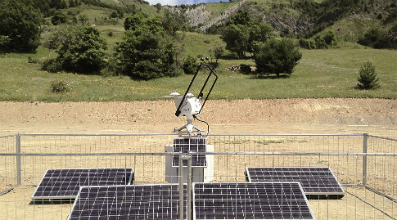High quality measurements during the planning phase of a solar farm significantly reduce the investment risk. In turn, a lower risk leads to improved conditions for project funding or, in extreme cases, makes funding possible at all! In any case the banks will have a very close look at the project, the potential energy yield, and how it was measured.
Also, at existing solar farms, accurate measurements can be an asset. Comparing the actual performance of the solar farm with the potential power output of the actual available solar irradiation indicates ways to optimise the performance of the generating system.
Ge:Net has already installed 12 new solar stations at different sites in Italy and France. They measure global radiation, diffuse radiation, albedo and additional weather data such as wind speed, wind direction, temperature, air pressure and humidity. Only high quality sensors are used, such as pyranometers and albedometers from Kipp & Zonen.
Stations with regular access for adjustment use the CM 121 Shadow Ring for the diffuse radiation pyranometer, as shown in the picture. Direct irradiance can be calculated from high quality diffuse and global radiation measurements with a good level of uncertainty.
 For stations where the shadow ring cannot be regularly adjusted a special highlight is the SOLYS 2 sun tracker from Kipp & Zonen fitted with a pyrheliometer, which automatically follows the position of the sun, measures the direct radiation and precisely shades a pyranometer.
For stations where the shadow ring cannot be regularly adjusted a special highlight is the SOLYS 2 sun tracker from Kipp & Zonen fitted with a pyrheliometer, which automatically follows the position of the sun, measures the direct radiation and precisely shades a pyranometer.
It is mainly the special characteristics of photovoltaic cells which call for such effort and accuracy in measurement, because of their wide field of view they can use both direct radiation and diffuse radiation to produce energy. Direct radiation is the proportion of the radiation from the sun that reaches the Earth’s surface without diffraction, diffusion or reflection; whereas diffuse radiation is reflected and scattered from particles in the air and is distributed all over the sky. The blue of the sky on a sunny day is diffuse radiation, as is the grey of the clouds.
Direct and diffuse radiations differ not only in intensity but in direction. As the performance of a photovoltaic cell is highly dependent upon the angle at which the radiation hits the cell it is most important to know the ratio of direct and diffuse radiation to find the ideal orientation for the solar modules.
Now, with the new solar stations from Ge:Net and the high quality equipment from Kipp & Zonen, the performance of a solar farm can be optimised by adjusting the angle of the solar modules, and financial risks can be minimised.
Ge:Net has specialised in wind energy resource measurement since 2001 and has now expanded into the solar energy resource market. Find out more at www.genetworld.com.